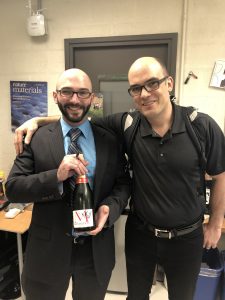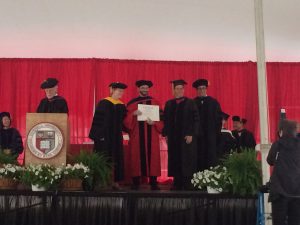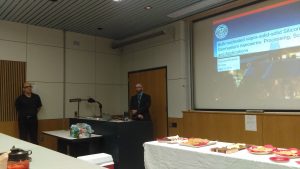Congratulations, Dr. Richards! for successfully defending your PhD thesis. Pictures from the defense and abstract of the presentation are below.

post-defense champagne.

graduation ceremony

Q&A session

‘the audience’
Bulk-nucleated vapor-solid-solid Silicon and Germanium Nanowires: Synthesis, Scaling, and Applications
Benjamin T. Richards
Cornell University, 2018
Nanowires are essential building blocks for many next-generation devices. This includes applications in solar cells, field effect transistors, thermoelectric generators, chemical sensors, and electrochemical cells. One application of intense promise is using silicon and germanium nanowires as anodes materials in lithium ion batteries, as these materials form stable compounds with superior lithium capacity that increases the anode charge capacity compared to current Li-ion batteries by a factor of 4 – 10. Unlike the bulk material, nanowires have been demonstrated to withstand the ~400% volume dilation due to the intercalation of lithium. To bring the acclaimed potential of nanowires to fruition, challenges in production, scaling, and electrochemical performance must be resolved. Conventional nanowire synthesis methods produce small yields of nanowires that require many processes (i.e., slurry mixing, coating, baking) to introduce into batteries. To meet the growing energy storage demands for personal electronics and electric vehicles, an improved method is required to produce nanowires.
In this work, I will introduce a growth mechanism that is simple, robust, and adaptable to high throughput processing of nucleating and growing nanowires from bulk metal films, known as bulk nucleated vapor-solid-solid (BN-VSS). This method prepares nanowires that are epitaxially connected to the metal substrate, allowing direct integration into batteries. I identify the kinetic conditions required to grow nanowires, the processes that occur during nanowire growth, and copper as a promising growth substrate material. Then, I will present a kinetic model of germanium nanowire growth from copper films using diphenylgermane as a precursor. This model was developed by performing rapid syntheses of nanowires using an inductive heating apparatus followed by ex-situ characterization of these films. Finally, I introduce a diagnostic technique of measuring the electrical resistance of the growth substrate to monitor the solid-state transformation that proceeds to germanium nanowire growth and demonstrate how this method can be used to inform kinetic conditions in high-throughput roll-to-roll reactors.

